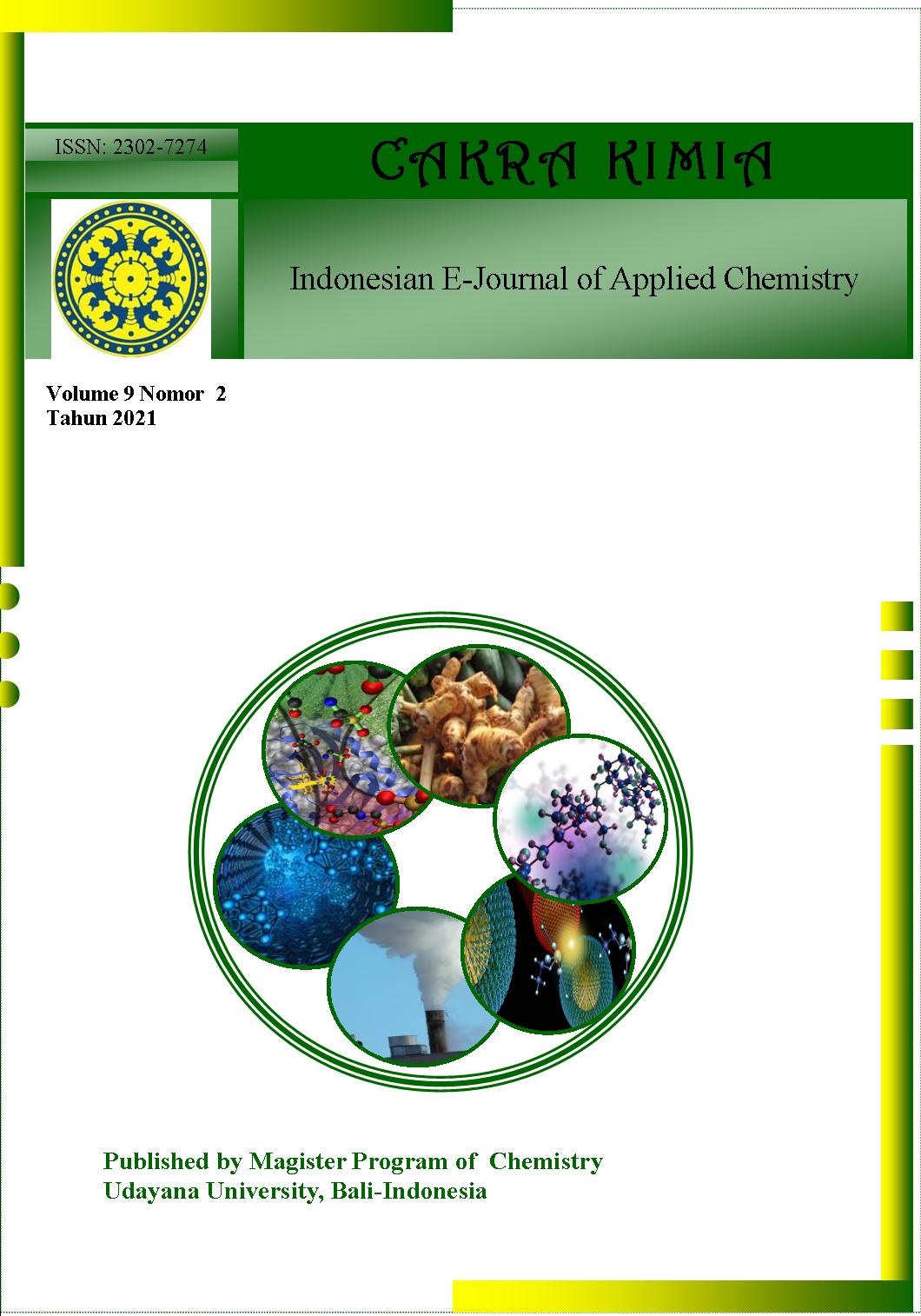BIOSINTESIS NANOPARTIKEL PERAK MENGGUNAKAN EKSTRAK AIR DAUN CEMMEM (Spondias pinnata (L.f) Kurz.) DAN AKTIVITASNYA SEBBAI ANTIBAKTERI
Abstract
ABSTRAK: Nanopartikel perak (NPAg) dibuat dengan metode green synthesis dengan memanfaatkan bahan alam sebagai bioreduktor, seperti daun cemcem. Tujuan dari penelitian ini yaitu memanfaatkan ekstrak air daun cemcem (Spondias pinnata (L.f) Kurz.) sebagai bioreduktor untuk pembentukan nanopartikel perak dan menguji aktivitasnya sebagai antibakteri. Proses ini dimulai dengan mencampur ekstrak konsentrasi 0,5; 0,75; dan 1% dengan larutan 1 mM AgNO3 dengan perbandingan 1:10. Campuran dipanaskan dengan suhu 25; 40; dan 60°C. NPAg dikarakterisasi dengan spektrofotometer UV-Vis dimana hasil menunjukkan bahwa panjang gelombang NPAg antara 416 – 435 nm. Hasil PSA menunjukkan bahwa penggunaan ekstrak dengan konsentrasi 0,5% dengan suhu 60°C menghasilkan partikel dengan ukuran yang paling kecil yaitu sebesar 30,56 ± 0,24 nm. Pengujian antibakteri menunjukkan bahwa NPAg memiliki daya hambat yang tergolong sedang (6-10 mm).
ABSTRACT: Silver nanoparticles (AgNPs) are made by green synthesis method by utilizing natural materials as bioreductants, such as cemcem leaves. The purpose of this study were to utilize the aqueous extract of the leaves of cemcem (Spondias pinnata (L.f) Kurz.) as a bioreductor for the formation of silver nanoparticles and to test its antibacterial activity. This process is started by mixing the extract concentration 0.5; 0.75; and 1% with 1 mM AgNO3 solution with a ratio of 1:10. The mixture was heated at temperature of 25; 40; and 60°C. AgNPs were characterized using a UV-Vis spectrophotometer where the results showed that the AgNPs wavelength was between 416 – 435 nm. The PSA results showed that the use of extracts with a concentration of 0.5% at a temperature of 60°C produced particles with the smallest size of 30.56 ± 0,24 nm. Antibacterial testing showed that AgNPs had moderate inhibitory power (6-10 mm).
Downloads
References
[2] Kim, S.H., Seon H., Lee, D.S. Ryu, S.J., Choi D.S. Antibacterial Activity of Silver-Nanoparticles Against Staphylococcus aureus and Escherichia coli. Korean J. Microbiol. Biotechnol. 2011, 39(1), 77-85.
[3] Jayaprakash, N.,Judith, Vijaya, John Kennedy, Priadharsini K., Palani, P. One step phytosynthesis of highly stabilized silver nanoparticles using Piper nigrum extract and their antibacterial activity. Materials Letters. 2014, 137, 358-361
[4] Otari, S. V., Patil, R.M., Ghosh, S.J., Pawar, S.H. Green phytosynthesis of silver nanoparticles using aqueous extract of Manilkara zapota (L.) seeds and its inhibitory action against Candida species. Materials Letters, 2014, 116, 367–369
[5] Velmurugan, P., Min Cho, Sung-Sik Lim, Sang-Ki Seo, Hyun Myung, Keuk-Soo Bang, Subpiramaniyam Sivakumar, Kwang-Min Cho, Byung-Taek Oh. Phytosynthesis of silver nanoparticles by Prunus yedoensis leaf extract and their antimicrobial activity. Materials Letters. 2015, 138, 272–275
[6] Keat, C.L., Aziz, A., Eid, A.M., Elmarguzi, N.A. Biosynthesis of Nanoparticles and Silver Nanoparticles. Bioresources and Bioprocessing. 2015, 2(47).
[7] Daphne, J., Francis, A., Mohanty, R., Ojha, N., Das, N. Green synthesis ofantibacterial silver nanoparticles using yeast isolates and its characterization.Res J Pharm Technol. 2018, 11(1), 83–92.
[8] Jain, P., Hossain, K.R., Mishu, T.R., Reza, H.M. Antioxidant and Antibacterial Activities of Spondias pinnata Kurz. Leaves. European Journal of Medicinal Plants. 2014, 4, 183-195.
[9] Michalak, A. Phenolic Compounds and Their Antioxidant Activity in Plants Growing under Heavy Metal Stress. Polish Journal of Environmental Studies. 2006, 15(4), 523-530
[10] Creswell, C. J., Kosasih, P., Iwang, S. 2005. Analisis Spektrum senyawa Organik. Cetakan ke-10 Edisi ketiga. Bandung: Penerbit ITB Hal : 1-10
[11] Masakke, Y., Sulfikar, Rasyid, M. Biosynthesis Of Silver Nanoparticles Using Methanol Extract Of Mangosteen Leaves (Garcinia Mangostana L.)’, Jurnal Sainsmat. 2015.
[12] Cao, Huiliang. Silver Nanoparticles for Antibacterial Devices Biocompatibility and Toxicity. CRC Press. 2017
[13] Fatimah, Mutiara, N.A.L. Biosynthesis of silver nanoparticles using putri malu (Mimosa pudica) leaves extract and microwave irradiation method. Jurnal molekul. 2016, 11(2), 288-298.
[14] Wahyudi T, Sugiyana, Helmy. Sintesis Nanopartikel Perak dan Uji Aktivitasnya terhadap Bakteri E.Coli dan S.Aureus. Arena Tekstil. 2011, 26(1).
[15] Jae Yong Song, Beom Soo Kim, Rapid biological synthesis of silver nanoparticles using plant leaf extracts, Bioprocess and Biosystems Engineering, 32, 1, (2008) 79 https://d0i.0rg/10.1007/s00449-008-0224-6
[16] Lestari, G.A.D., Suprihatin, I.E., Sibarani, J. Sintesis Nanopartikel Perak (NPAg) Menggunakan Ekstrak Air Buah Andaliman (Zanthoxylum acanthopodium DC.) dan Aplikasinya pada Fotodegradasi Indigosol Blue. Jurnal Kimia Sains dan Aplikasi. 2019, 22(5), 200-205



 Petunjuk Penulisan
Petunjuk Penulisan
